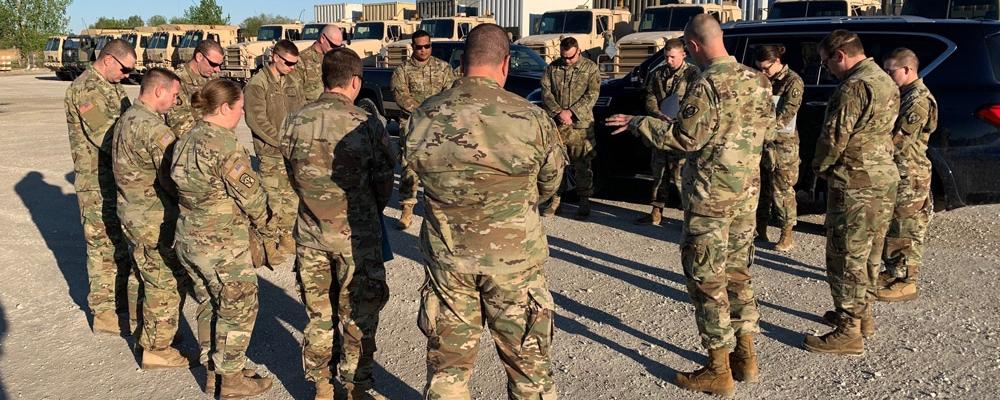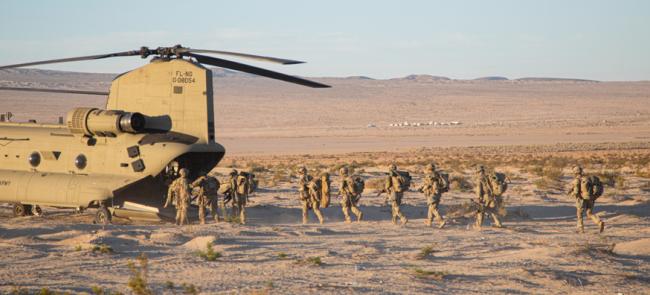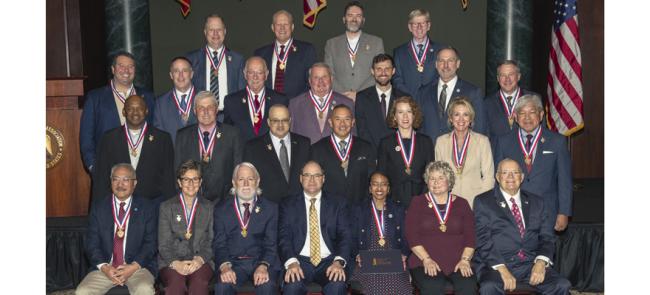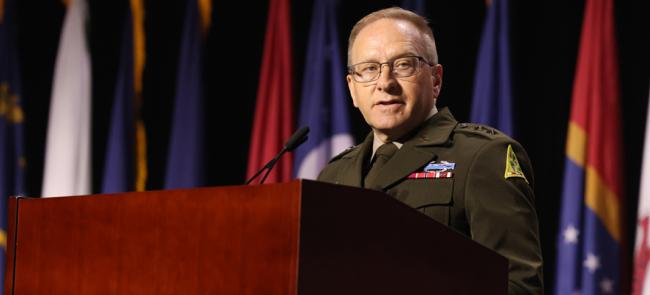
All Ears
Something was wrong. Chaplain (Col.) Robert Morris saw it as he recently watched an Idaho Army National Guard company run two miles in preparation for an upcoming PT test.
While most of the soldiers ran around the track together, one soldier was about a half-mile back. “I want to see that man,” Morris, the Idaho state chaplain, told the squad leader.
The soldier in question had a lot weighing him down that day on the track. With a nationwide pandemic raging, he was unemployed from his civilian job with no food and no money
“If I take my life, the family will get insurance and they’ll be okay,” the soldier told the chaplain. But he lacked the money to even buy ammunition for the suicide attempt.
“He was really stressed,” says Morris. “He felt like his life had no meaning.”
Morris got the family some groceries. He arranged for the soldier to go on active duty as part of the state COVID task force while he looked for civilian work. Morris then connected the soldier to behavioral health and financial counseling.
“As a chaplain, you’re able to see those things,” Morris adds. “You’re embedded with them. ... They’ll open up to you.”
Chaplain (Col.) Larry Bazer, the Army Guard staff chaplain for the National Guard Bureau, says the pandemic changed some of the ways chaplains operate, but not their overall mission, which dates back the Revolutionary War. Back then, clergy fought alongside the minutemen, Bazer explains.
According to NGB, General George Washington started the chaplain corps in 1775. Since then, thousands of chaplains have served in the militia or National Guard and have participated in every U.S. war and military action.
Chaplains are “noncombatants” so they carry no weapons. That’s how the role of chaplain assistant started. They’re now called religious affairs personnel, and they function as bodyguards for chaplains in deployments. Calvin P. Titus was a chaplain assistant and received the Medal of Honor for his actions during the Boxer Rebellion in 1900.
The Guard currently has about 1,000 chaplains and 900 enlisted religious affairs personnel, Bazer says, representing more than 70 different denominations and faith groups. But less than 12% are full-time. And many positions are vacant. The Army Guard is authorized 813 chaplains, but only has 658 in its ranks.
The year 2020 has been called the Year of the Guard by some military leaders, pointing to missions related to the ongoing pandemic, periods of civil unrest and numerous natural disasters.
The role of chaplain has always been a difficult one. But the past year added new stress, chaplains say. “We had a lot of very distraught people,” Morris says, “a lot of issues from unresolved grief.”
Idaho lost five Guardsmen to suicide in 2020. The reasons varied, but one element was common in all of them. “People were having a hard time coping with the stress of isolation,” he says. “It’s a lack of sleep, diet and exercise.”
We keep soldiers in the mission and in the fight because we listen.
—Chaplain (Maj.) Lance Sellon, a chaplain with the Florida Army National Guard's 53rd Infantry Brigade Combat Team
MEANWHILE, the pandemic has reshaped the ministry once offered by Guard chaplains, forcing much of their work online.
In Hawaii, an airman assigned to the Army Guard’s 298th Air Defense Group left his job with a phone company early due to body aches and fatigue. Several days later he died from COVID. “It was a shock because he was a healthy man,” says Chaplain (Col.) Leah Boling. “He was our first casualty.”
Boling, the Air National Guard assistant to the Air Mobility Command chaplain, is stationed at Joint Base Pearl Harbor-Hickam in Hawaii. She provided a virtual grief briefing and memorial service for the group due to limits on in-person meetings at the time.
“It was sad,” she says. “You could feel the grief.”
Chaplain (Capt.) Colin Lau is a chaplain with the Hawaii’s Army Guard’s 29th Infantry Brigade Combat Team. Before the pandemic, most of his time was in administrative work. Then his soldiers were sequestered for two months on base or in hotels during the pandemic. Lau found himself having to mediate conflicts in marriages as stress levels increased.
The pandemic isn’t the only driver of stress within the force. The Guard has been in high demand for the past year, completing numerous domestic missions while still supporting long-standing overseas missions.
During bouts of civil unrest, chaplains in some states helped Guardsmen who were being harassed by members of their own family who questioned their loyalty and duty.
Chaplain (Capt.) Brandon Sanders, a chaplain with the Washington Army Guard’s 81st Stryker Brigade Combat Team, says his soldiers expected to serve five days in support of law enforcement working riots last summer in Seattle, but ended up spending a month on the mission.
The soldiers helped the Seattle Police on their line as protesters approached in groups. They would post 20 to 30 soldiers on each shift and found themselves facing hardcore anarchists that would taunt the soldiers and throw bottles of urine.
“Some people had their families divided,” Sanders says. “There are legitimate protests happening in other parts of the city,” he says, but the opposition they faced just wanted to destroy property.
He went into the riots with the troops as he backed them up and gave them encouragement on the line. The protesters would taunt soldiers. Sanders would pat guard members on the back and tell them to stand firm.
“A lot of times, we were sleeping two hours a night,” Sanders says about his work there. “That shared suffering opened the door.”
Chaplain (Capt.) Chad Gion, a chaplain with the North Dakota Army Guard’s 164th Engineer Battalion, says he’s seen more suicide ideation in soldiers he’s spoken with since the pandemic began.
He typically practices what he calls a “ministry of presence,”serving alongside soldiers in the field. In a normal year, Gion would help a unit training set up their tents. His chief role would be to be available, to be ready when a soldier sidles up and says “Hey chap, can we talk?”
Those talks can run the gamut, from questions on the meaning of life to conversations about a break-up or spat with parents. But during a pandemic “it’s gotten more digital with email and texts,” he says. And Gion worries that soldiers have less opportunities to talk about spiritual beliefs and other issues with their chaplain.
Resilience is one of the things we focus on.
—Chaplain (Maj.) Saul Castillo, the division chaplain for the California Army National Guard's 40th Infantry Division
IN SOME WAYS, the limitations of a pandemic meant chaplains have had less opportunities to strike up conversations with soldiers about their issues or spiritual beliefs. In other ways, it had driven the demand.
Chaplain (Maj.) Lance Sellon supervises seven chaplains with the Florida’s 53rd Infantry Brigade Combat Team. Before the pandemic, those chaplains averaged 50 counseling sessions a month. Now they see 50 to 100 a week.
Some soldiers have spent months on duty. That is stressing their home lives. Others are battling issues related to the pandemic, struggling to pay bills or coping with the illness of a loved one.
“We’re all seeing the same things,” Sellon says. “The soldiers are stressed just like the rest of society.”
In some cases, chaplains can link soldiers and airmen to programs that can help pay the bills and provide support. In other instances, they serve as a sounding board for the Guardsman.
“If you don’t talk it out, you’ll act it out,” Sellon says.
He believes chaplains don’t need to have all the answers. Instead, they can work as a conduit to help soldiers find solutions to their problems that suit them best.
“Most people will talk themselves towards their own solutions,” he says. “We keep soldiers in the mission and in the fight because we listen.”
Sellon says he encourages Guardsmen to talk about the issues impacting their lives, if not to a chaplain, than at least to a battle buddy. “These are America’s sons and daughters who are helping us to get through this,” he says. “I can’t help but be inspired by the men and women I work with.”
Chaplain (Maj.) Saul Castillo, the division chaplain for the California Army Guard’s 40th Infantry Division, says the pandemic has made the role of a chaplain more unpredictable.
“Now, we are finding ourselves dealing with more mental and emotional issues,” he says. “The number of people we are counseling has gone up tenfold.” Castillo, who also oversees all chaplains in the California Army Guard, says he has encouraged his team to use social media and other online platforms.
“There’s a lot of trauma fatigue that accumulates,” Castillo says of the ongoing pandemic and its related missions. “Resilience is one of the things that we focus on.”
Chaplains were also among the 26,000 Guard soldiers and airmen who supported the security mission at the U.S. Capitol in Washington, D.C., earlier this year.
“Wherever there are soldiers, that’s pretty much where I’m going to be,” says Chaplain (Capt.) Scott Stout, the chaplain for the Indiana Indiana Army Guard’s 1st Battalion, 293rd Infantry Regiment, who went with the unit to overseas exercises Slovak Shield in 2019 and Pacific Pathways in 2018.
On Capitol Hill, it meant 12-14 hour days visiting troops wherever they were posted.
“It’s par for the course for the job of being a chaplain,” Stout says. “Whatever they need and whenever they need it. It’s kinda just what we do.”
Clay Renick is a Sylvania, Georgia-based freelance writer who specializes in military subjects. He can be reached via [email protected].



